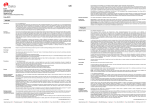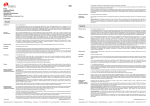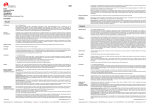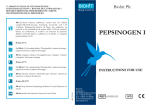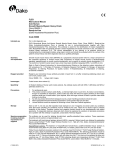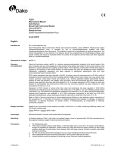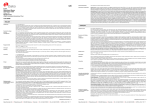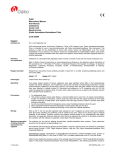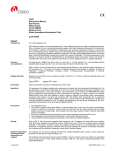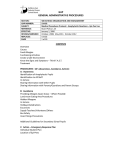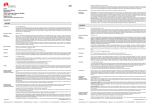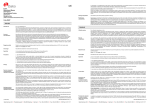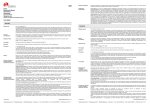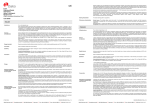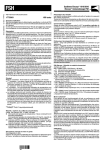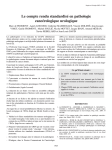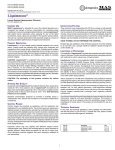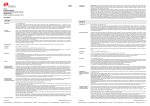Download FLEX Polyclonal Rabbit Anti-Human Alpha-1-Fetoprotein
Transcript
Positive and negative controls should be run simultaneously using the same protocol as the patient specimens. The positive control tissue should include embryonal carcinoma and the cells/structures should display reaction patterns as described for this tissue in “Performance characteristics” in all positive specimens. The recommended negative control reagent is FLEX Negative Control, Rabbit, (Dako Autostainer/Autostainer Plus) (Code IS600). FLEX Polyclonal Rabbit Anti-Human Alpha-1-Fetoprotein Ready-to-Use (Dako Autostainer/Autostainer Plus) Staining interpretation Cells labeled by the antibody display cytoplasmic staining (1). Performance characteristics Normal tissues: In a 20-day old human conceptus, the antibody labels the endodermal cells of the inner surface of the yolk sac. In the amnion AFP is also demonstrated (9). Abnormal tissues: 189 orchidectomy specimens with germ cell tumors (95 pure seminomas and 94 non-seminomas) were studied with the antibody. All seminomas were AFP negative, while 66% of the non-seminomas were positively stained for AFP. 21% of pure embryonal carcinomas (EC), 25% of EC components in mixed tumors, all yolk sac tumor components, 20% of pure teratomas (T) and 47% of T components were AFP positive. Carcinoma-in-situ present in seminiferous tubules adjacent to the tumors was never positively stained for AFP (1). In stomach cancers with elevated serum AFP levels, 19/35 (54%) were labeled by the antibody (2). Focally, neoplastic cells of embryonal carcinoma show a moderate to strong staining reaction. Code IS500 ENGLISH FRANÇAIS Intended use For in vitro diagnostic use. FLEX Polyclonal Rabbit Anti-Human Alpha-1-Fetoprotein, Ready-to-Use, (Dako Autostainer/Autostainer Plus), is intended for use in immunohistochemistry together with Dako Autostainer/Autostainer Plus instruments. Antibodies to Alpha-1-Fetprotein may be useful for the identification of non-neoplastic and neoplastic liver disease, yolk sac tumors and mixed germ cell tumors (1-3). The clinical interpretation of any staining or its absence should be complemented by morphological studies using proper controls and should be evaluated within the context of the patient's clinical history and other diagnostic tests by a qualified pathologist. Summary and explanation Alpha-1-fetoprotein (AFP) is a 70 kDa glycoprotein containing 590 amino acid residues. Cells of the embryonic yolk sac, fetal liver, and fetal intestinal tract synthesize this glycoprotein (4, 5). AFP is a very useful marker for the detection of numerous developmental defects and various pathologies, whether cancerous or not (6). Expression of AFP has been demonstrated in about 44% of hepatocellular carcinomas, and in gonadal and extragonadal germ cells tumors, including yolk sac tumors. AFP has not been detected in normal adult tissue by immunostaining (4). However, traces of AFP are found in normal adult sera and in greater concentrations in maternal and foetal sera and amniotic fluid (7). Refer to Dako’s General Instructions for Immunohistochemical Staining or the detection system instructions of IHC procedures for: 1) Principle of Procedure, 2) Materials Required, Not Supplied, 3) Storage, 4) Specimen Preparation, 5) Staining Procedure, 6) Quality Control, 7) Troubleshooting, 8) Interpretation of Staining, 9) General Limitations. Reagent provided Ready-to-use polyclonal rabbit antibody provided in liquid form in a buffer containing stabilizing protein and 0.015 mol/L sodium azide. Immunogen Alpha-1-fetoprotein isolated from human cord serum. Specificity The antibody reacts with human alpha-1-fetoprotein. Traces of contaminating antibodies have been removed by solid-phase absorption with human plasma proteins. In indirect ELISA no significant reaction is observed with normal human plasma. As demonstrated by rocket immunoelectrophoresis, the antibody cross-reacts with the AFP-equivalent protein in cat and wildebeest (8). Precautions 1. For professional users. 2. This product contains sodium azide (NaN3), a chemical highly toxic in pure form. At product concentrations, though not classified as hazardous, sodium azide may react with lead and copper plumbing to form highly explosive build-ups of metal azides. Upon disposal, flush with large volumes of water to prevent metal azide build-up in plumbing. 3. As with any product derived from biological sources, proper handling procedures should be used. 4. Wear appropriate Personal Protective Equipment to avoid contact with eyes and skin. 5. Unused solution should be disposed of according to local, State and Federal regulations. Storage Store at 2-8 °C. Do not use after expiration date sta mped on vial. If reagents are stored under any conditions other than those specified, the conditions must be verified by the user. There are no obvious signs to indicate instability of this product. Therefore, positive and negative controls should be run simultaneously with patient specimens. If unexpected staining is observed which cannot be explained by variations in laboratory procedures and a problem with the antibody is suspected, contact Dako Technical Support. Specimen preparation including materials required but not supplied The antibody can be used for labeling formalin-fixed, paraffin-embedded tissue sections. Tissue specimens should be cut into sections of approximately 4 µm. Pre-treatment with heat-induced epitope retrieval (HIER) is required using Dako PT Link (Code PT100/PT101). For details, please refer to the PT Link User Guide. Optimal results are obtained by pretreating tissues using EnVision FLEX Target Retrieval Solution, High pH (50x) (Code K8010/K8004). Paraffin-embedded sections: Pre-treatment of formalin-fixed, paraffin-embedded tissue sections is recommended using the 3-in-1 specimen preparation procedure for Dako PT Link. Follow the pre-treatment procedure outlined in the package insert for EnVision FLEX Target Retrieval Solution, High pH (50x) (Code K8010/K8004). Note: After staining the sections must be dehydrated, cleared and mounted using permanent mounting medium. Deparaffinized sections: Pre-treatment of deparaffinized formalin-fixed, paraffin-embedded tissue sections is recommended using Dako PT Link and following the same procedure as described for paraffin-embedded sections. After staining the slides should be mounted using aqueous or permanent mounting medium. The tissue sections should not dry out during the treatment or during the following immunohistochemical staining procedure. For greater adherence of tissue sections to glass slides, the use of FLEX IHC Microscope Slides (Code K8020) is recommended. Staining procedure including materials required but not supplied Utilisation prévue Pour utilisation diagnostique in vitro. FLEX Polyclonal Rabbit Anti-Human Alpha-1-Fetoprotein, Ready-to-Use, (Dako Autostainer/Autostainer Plus) est destiné à une utilisation en immunohistochimie avec les instruments Dako Autostainer/Autostainer Plus. Les anticorps anti-alpha-1-fœtoprotéine peuvent être utiles pour l’identification des hépatites non néoplasiques et néoplasiques, des tumeurs de la membrane vitelline et les tumeurs à cellules germinales mixtes (1–3). L’interprétation clinique de toute coloration ou son absence doit être complétée par des études morphologiques en utilisant des contrôles appropriés et doit être évaluée en fonction des antécédents cliniques du patient et d’autres tests diagnostiques par un pathologiste qualifié. Résumé et explication Alpha-1-fetoprotein (AFP) est une glycoprotéine de poids moléculaire 70 kDa contenant 590 acides aminés. Les cellules du sac vitellin embryonnaire, du foie fœtal, et le tractus intestinal fœtal synthétisent cette glycoprotéine (4, 5). L’AFP est un marqueur très important pour la détection de nombreux défauts de développement et diverses pathologies, d’origine cancéreuse ou non (6). L’expression de l’AFP a été observée dans environ 44 % des carcinomes hépatocellulaires, et dans les tumeurs à cellules germinales gonadiques et extragonadiques, y compris les tumeurs du sac vitellin. L’AFP n’a pas été détectée dans les tissus sains adultes par coloration immunologique (4). Cependant, des traces d’AFP sont présentes dans des sérums adultes normaux et à des concentrations plus importantes dans les sérums maternel et fœtal et dans le liquide amniotique (7). Se référer aux Instructions générales de coloration immunohistochimique de Dako ou aux instructions du système de détection relatives aux procédures IHC pour plus d’informations concernant les points suivants : 1) Principe de procédure, 2) Matériels requis mais non fournis, 3) Conservation, 4) Préparation des échantillons, 5) Procédure de coloration, 6) Contrôle qualité, 7) Dépannage, 8) Interprétation de la coloration, 9) Limites générales. Réactifs fournis Anticorps polyclonal de lapin prêt à l’emploi fourni sous forme liquide dans un tampon contenant une protéine stabilisante et 0,015 mol/L d’azide de sodium. Immunogène Alpha-1-fœtoprotéine isolée à partir de sérum de cordon ombilical humain. Spécificité L’anticorps réagit avec l'alpha-1-fœprotéine humaine. Les traces d’anticorps contaminants ont été éliminées par absorption en phase solide en utilisant des protéines de plasma humain. Lors d’un test ELISA indirect, aucune réaction significative n’est observée avec le plasma humain normal. Comme le démontre l’immunoélectrophorèse en fusée, l’anticorps présente une réaction croisée avec la protéine homologue à l’AFP chez le chat et le gnou (8). Précautions 1. Pour utilisateurs professionnels. 2. Ce produit contient de l’azide de sodium (NaN3), produit chimique hautement toxique dans sa forme pure. Aux concentrations du produit, bien que non classé comme dangereux, l’azide de sodium peut réagir avec le cuivre et le plomb des canalisations et former des accumulations d’azides métalliques hautement explosifs. Lors de l’élimination, rincer abondamment à l’eau pour éviter toute accumulation d’azide métallique dans les canalisations. 3. Comme avec tout produit d’origine biologique, des procédures de manipulation appropriées doivent être respectées. 4. Porter un vêtement de protection approprié pour éviter le contact avec les yeux et la peau. 5. Les solutions non utilisées doivent être éliminées conformément aux réglementations locales et nationales. Conservation Conserver entre 2 et 8 °C. Ne pas utiliser après la date de péremption indiquée sur le flacon. Si les réactifs sont conservés dans des conditions autres que celles indiquées, celles-ci doivent être validées par l’utilisateur. Il n’y a aucun signe évident indiquant l’instabilité de ce produit. Par conséquent, des contrôles positifs et négatifs doivent être testés en même temps que les échantillons de patient. Si une coloration inattendue est observée, qui ne peut être expliquée par un changement des procédures du laboratoire, et en cas de suspicion d’un problème lié à l’anticorps, contacter l’assistance technique de Dako. Préparation des échantillons y compris le matériel requis mais non fourni L’anticorps peut être utilisé pour le marquage des coupes de tissus inclus en paraffine et fixés au formol. L’épaisseur des coupes d’échantillons de tissu doit être d’environ 4 µm. Un prétraitement avec démasquage d’épitope induit par la chaleur (HIER) est nécessaire avec le Dako PT Link (Réf. PT100/PT101). Pour plus de détails, se référer au Guide d’utilisation du PT Link. Des résultats optimaux sont obtenus en prétraitant les tissus à l’aide de la EnVision FLEX Target Retrieval Solution, High pH (50x) (Réf. K8010/K8004). Coupes incluses en paraffine : le prétraitement des coupes tissulaires fixées au formol et incluses en paraffine est recommandé à l'aide de la procédure de préparation d'échantillon 3-en-un pour le Dako PT Link. Suivre la procédure de prétraitement indiquée dans la notice de la EnVision FLEX Target Retrieval Solution, High pH (50x) (Réf. K8010/K8004). Remarque : après coloration, les coupes doivent être déshydratées, lavées et montées à l’aide d’un milieu de montage permanent. Coupes déparaffinées : le prétraitement des coupes tissulaires déparaffinées, fixées au formol et incluses en paraffine, est recommandé à l’aide du Dako PT Link, en suivant la même procédure que pour les coupes incluses en paraffine. Après coloration, un montage aqueux ou permanent des lames est recommandé. Les coupes de tissus ne doivent pas sécher lors du traitement ni lors de la procédure de coloration immunohistochimique suivante. Pour une meilleure adhérence des coupes de tissus sur les lames de verre, il est recommandé d’utiliser des lames FLEX IHC Microscope Slides (Réf. K8020). Procédure de coloration y compris le matériel requis mais non fourni Le système de visualisation recommandé est EnVision FLEX, High pH, (Dako Autostainer/Autostainer Plus) (Réf. K8010). Les étapes de coloration et d’incubation sont préprogrammées dans le logiciel des instruments Dako Autostainer/Autostainer Plus, à l’aide des protocoles suivants : The recommended visualization system is EnVision FLEX, High pH, (Dako Autostainer/Autostainer Plus) (Code K8010). The staining steps and incubation times are pre-programmed into the software of Dako Autostainer/Autostainer Plus instruments, using the following protocols: Template protocol: FLEXRTU2 (200 µL dispense volume) or FLEXRTU3 (300 µL dispense volume) Autoprogram: AFP (without counterstaining) or AFPH (with counterstaining) The Auxiliary step should be set to “rinse buffer” in staining runs with ≤10 slides. For staining runs with >10 slides the Auxiliary step should be set to “none”. This ascertains comparable wash times. All incubation steps should be performed at room temperature. For details, please refer to the Operator’s Manual for the dedicated instrument. If the protocols are not available on the used Dako Autostainer instrument, please contact Dako Technical Services. Optimal conditions may vary depending on specimen and preparation methods, and should be determined by each individual laboratory. If the evaluating pathologist should desire a different staining intensity, a Dako Application Specialist/Technical Service Specialist can be contacted for information on re-programming of the protocol. Verify that the performance of the adjusted protocol is still valid by evaluating that the staining pattern is identical to the staining pattern described in “Performance characteristics”. Counterstaining in hematoxylin is recommended using EnVision FLEX Hematoxylin, (Dako Autostainer/Autostainer Plus) (Code K8018). Nonaqueous, permanent mounting medium is recommended. (115250-002) Dako Denmark A/S IS500/EFG/MNI/2009.12.04 p. 1/4 | Produktionsvej 42 | DK-2600 Glostrup | Denmark | Tel. +45 44 85 95 00 | Fax +45 44 85 95 95 | CVR No. 33 21 13 17 (115250-002) Dako Denmark A/S IS500/EFG/MNI/2009.12.04 p. 2/4 | Produktionsvej 42 | DK-2600 Glostrup | Denmark | Tel. +45 44 85 95 00 | Fax +45 44 85 95 95 | CVR No. 33 21 13 17 Probenvorbereitungsverfahren für Dako PT Link wird empfohlen. Vorbehandlung gemäß der Beschreibung in der Packungsbeilage für EnVision FLEX Target Retrieval Solution, High pH (50x) (Code-Nr. K8010/K8004) durchführen. Hinweis: Nach dem Färben müssen die Schnitte dehydriert, geklärt und mit permanentem Einbettmedium auf den Objektträger aufgebracht werden. Entparaffinierte Schnitte: Eine Vorbehandlung der entparaffinierten, formalinfixierten, paraffineingebetteten Gewebeschnitte mit Dako PT Link nach demselben Verfahren, wie für die paraffineingebetteten Schnitte beschrieben, wird empfohlen. Die Objektträger nach dem Färben mit einem wässrigen oder permanenten Einbettmedium bedecken. Die Gewebeschnitte dürfen während der Behandlung oder des anschließenden immunhistochemischen Färbeverfahrens nicht austrocknen. Zur besseren Haftung der Gewebeschnitte an den Glasobjektträgern wird die Verwendung von FLEX IHC Microscope Slides (Code-Nr. K8020) empfohlen. Protocole modèle : FLEXRTU2 (volume de distribution de 200 µL) ou FLEXRTU3 (volume de distribution de 300 µL)Autoprogram : AFP (sans contre-coloration) ou AFPH (avec contre-coloration) L’étape Auxiliary doit être réglée sur « rinse buffer » lors des cycles de coloration avec ≤10 lames. Pour les cycles de coloration de >10 lames, l’étape Auxiliary doit être réglée sur « none ». Cela garantit des temps de lavage comparables. Toutes les étapes d’incubation doivent être effectuées à température ambiante. Pour plus de détails, se référer au Manuel de l’opérateur spécifique à l'instrument. Si les protocoles ne sont pas disponibles sur l’instrument Dako Autostainer utilisé, contacter le service technique de Dako. Les conditions optimales peuvent varier en fonction du prélèvement et des méthodes de préparation, et doivent être déterminées par chaque laboratoire individuellement. Si le pathologiste qui réalise l’évaluation désire une intensité de coloration différente, un spécialiste d’application/spécialiste du service technique de Dako peut être contacté pour obtenir des informations sur la re-programmation du protocole. Vérifier que l'exécution du protocole modifié est toujours valide en vérifiant que le schéma de coloration est identique au schéma de coloration décrit dans les « Caractéristiques de performance ». Il est recommandé d’effectuer une contre-coloration à l’aide de EnVision FLEX Hematoxylin, (Dako Autostainer/Autostainer Plus) (Réf. K8018). L’utilisation d’un milieu de montage permanent non aqueux est recommandée. Des contrôles positifs et négatifs doivent être réalisés en même temps et avec le même protocole que les échantillons du patient. Le contrôle de tissu positif doit comprendre le carcinome embryonnaire et les cellules/structures doivent présenter des schémas de réaction tels que décrits pour ces tissus dans les « Caractéristiques de performance » pour tous les échantillons positifs. Le contrôle négatif recommandé est le FLEX Negative Control, Rabbit, (Dako Autostainer/Autostainer Plus) (Réf. IS600). Interprétation de la coloration Les cellules marquées par l’anticorps présentent une coloration cytoplasmique (1). Caractéristiques de performance Tissus sains : Chez un produit de conception humain de 20 jours, l’anticorps marque les cellules endodermiques de la surface interne du sac vitellin. L'AFP est également présente dans l’amnios (9). Tissus tumoraux : 189 échantillons d’orchidectomie contenant des tumeurs à cellules germinales (95 séminomes purs et 94 non séminomes) ont été étudiés avec l’anticorps. Tous les séminomes étaient négatifs à l’AFP, alors que 66 % des non séminomes étaient marqués positivement pour l’AFP. 21 % des carcinomes embryonnaires purs, 25 % des composants de carcinomes embryonnaires dans les cas de tumeurs mixtes, tous les composants de tumeurs du sac vitellin, 20 % des tératomes purs (T) et 47 % des composants T étaient positifs à l’AFP. Un carcinome in situ présent dans les tubules séminifères adjacents aux tumeurs n’a jamais été coloré de manière positive à l’AFP (1). Dans les cancers de l’estomac accompagnés de taux d'AFP sérique élevés, 19 cas sur 35 (54 %) ont été marqués par l’anticorps (2). Par endroits, les cellules néoplasiques du carcinome embryonnaire indiquent une réaction de coloration modérée à forte. DEUTSCH Zweckbestimmung Zur In-vitro-Diagnostik. FLEX Polyclonal Rabbit Anti-Human Alpha-1-Fetoprotein, Ready-to-Use, (Dako Autostainer/Autostainer Plus) ist zur Verwendung in der Immunhistochemie in Verbindung mit Dako Autostainer/Autostainer Plus-Geräten bestimmt. Antikörper gegen Alpha-1-Fetoprotein können bei der Identifikation nicht-neoplastischer und neoplastischer Lebererkrankungen, Dottersacktumore und gemischter Keimzellentumore hilfreich sein (1–3). Die klinische Auswertung einer eventuell eintretenden Färbung sollte durch morphologische Studien mit ordnungsgemäßen Kontrollen ergänzt werden und von einem qualifizierten Pathologen unter Berücksichtigung der Krankengeschichte und anderer Diagnostiktests des Patienten vorgenommen werden. Zusammenfassung und Erklärung Alpha-1-Fetoprotein (AFP) ist ein 70-kDa-Glykoprotein, das 590 Aminosäurerückstände enthält. Dieses Glykoprotein wird von Zellen des embryonischen Dottersacks, der fötalen Leber und des fötalen Intestinaltrakts synthetisiert (4, 5). AFP ist ein sehr hilfreicher Marker für den Nachweis zahlreicher Entwicklungsdefekte und Pathologien, unabhängig davon, ob diese kanzerös sind oder nicht (6). Die Expression von AFP wurde in etwa 44 % hepatozellulärer Karzinome und in gonadalen und extragonadalen Keimzelltumoren, einschließlich Dottersacktumoren nachgewiesen. AFP wurde in normalem Erwachsenengewebe mittels Immunfärbung nicht nachgewiesen (4). Es wurden jedoch Spuren von AFP in normalem Erwachsenenserum und in größeren Konzentrationen in Mutter- und fötalen Seren sowie im Fruchtwasser gefunden (7). Folgende Angaben bitte den Allgemeinen Richtlinien zur immunhistochemischen Färbung von Dako oder den Anweisungen des Detektionssystems für IHC-Verfahren entnehmen: 1) Verfahrensprinzip, 2) Erforderliche, aber nicht mitgelieferte Materialien, 3) Aufbewahrung, 4) Vorbereitung der Probe, 5) Färbeverfahren, 6) Qualitätskontrolle, 7) Fehlersuche und -behebung, 8) Auswertung der Färbung, 9) Allgemeine Beschränkungen. Färbeverfahren und erforderliche, aber nicht mitgelieferte Materialien Das empfohlene Visualisierungssystem ist EnVision™ FLEX, High pH, (Dako Autostainer/Autostainer Plus)(Code-Nr. K8010). Die Färbeschritte und Inkubationszeiten sind in der Software der Dako Autostainer/Autostainer Plus-Geräte mit den folgenden Protokollen vorprogrammiert: Matrix-Protokoll: FLEXRTU2 (200 µL Abgabevolumen) oder FLEXRTU3 (300 µL Abgabevolumen) Autoprogram: AFP (ohne Gegenfärbung) oder AFPH (mit Gegenfärbung) Bei Färbedurchläufen mit höchstens 10 Objektträgern sollte der „Zusatz“-Schritt auf „Pufferspülgang“ eingestellt werden. Für Färbedurchläufe mit mehr als 10 Objektträgern den „Zusatz“-Schritt auf „Keine“ einstellen. Dieses gewährleistet vergleichbare Waschzeiten. Alle Inkubationsschritte sollten bei Raumtemperatur durchgeführt werden. Nähere Einzelheiten bitte dem Benutzerhandbuch für das jeweilige Gerät entnehmen. Wenn die Färbeprotokolle auf dem verwendeten Dako Autostainer-Gerät nicht verfügbar sind, bitte den Technischen Kundendienst von Dako verständigen. Optimale Bedingungen können je nach Probe und Präparationsverfahren unterschiedlich sein und sollten vom jeweiligen Labor selbst ermittelt werden. Falls der beurteilende Pathologe eine andere Färbungsintensität wünscht, kann ein Anwendungsspezialist oder Kundendiensttechniker von Dako bei der Neuprogrammierung des Protokolls helfen. Die Leistung des angepassten Protokolls muss verifiziert werden, indem gewährleistet wird, dass das Färbemuster mit dem unter „Leistungsmerkmale“ beschriebenen Färbemuster identisch ist. Die Gegenfärbung in Hämatoxylin sollte mit EnVision™ FLEX Hematoxylin (Dako Autostainer/Autostainer Plus) (Code-Nr. K8018) ausgeführt werden. Empfohlen wird ein nichtwässriges, permanentes Fixiermittel. Positiv- und Negativkontrollen sollten zur gleichen Zeit und mit demselben Protokoll wie die Patientenproben getestet werden. Das positive Kontrollgewebe sollte Embryonalkarzinom enthalten und die Zellen/Strukturen müssen in allen positiven Proben die für dieses Gewebe unter „Leistungsmerkmale“ beschriebenen Reaktionsmuster aufweisen. Das empfohlene Negativ-Kontrollreagenz ist FLEX Negative Control, Rabbit (Dako Autostainer/Autostainer Plus) (Code-Nr. IS600). Auswertung der Färbung Mit diesem Antikörper markierte Zellen weisen ein zytoplasmatisches Färbemuster auf (1). Leistungsmerkmale Gesundes Gewebe: Bei einem 20 Tage alten menschlichen Conceptus markiert der Antikörper die endodermalen Zellen der inneren Oberfläche des Dottersacks. Im Amnion wurde AFP ebenfalls nachgewiesen (9). Pathologisches Gewebe: Mit dem Antikörper wurden 189 Orchidektomieproben mit Keimzelltumoren (95 reine Seminome und 94 NichtSeminome) untersucht. Alle Seminome waren AFP-negativ, während sich 66 % der Nicht-Seminome positiv für AFP färbten. 21 % der reinen Embryonalkarzinome (EC), 25 % der EC-Komponenten in gemischten Tumoren, alle Komponenten des Dottersacktumors, 20 % der reinen Teratome (T) und 47 % der T-Komponenten waren AFP-positiv. Carcinoma in situ in den Hodenkanälchen in der Nähe der Tumore färbten sich niemals AFP-positiv (1). Bei Magenkrebs mit erhöhten Serum-AFP-Konzentrationen wurden 19 von 35 Fällen (54 %) vom Antikörper markiert (2). Neoplastische Zellen der Embryonalkarzinome zeigten örtlich begrenzt eine mäßige bis starke Färbereaktion. References/ Références/ Literatur 1. Jacobsen GK, Jacobsen M. Alpha-fetoprotein (AFP) and human chorionic gonadotropin (HCG) in testicular germ cell tumours. A prospective immunohistochemical study. Acta Path Microbiol Immunol Scand Sect A 1983; 91:165-76. 2. Kodama T, Kameya T, Hirota T, Shimosato Y, Ohkura H, Mukojima T, et al. Production of alpha-fetoprotein, normal serum proteins, and human chorionic gonadotropin in stomach cancer: Histologic and immunohistochemical analyses of 35 cases. Cancer 1981; 48:1647-55. 3. Perrone T, Steeper TA, Dehner LP. Alpha-fetoprotein localization in pure ovarian teratoma. An immunohistochemical study of 12 cases. Am J Clin Pathol 1987; 88:713-17. 4. Leong AS-Y, Cooper K, Leong FJW-M. Manual of diagnostic antibodies for immunohistology; London: Oxford University Press; 1999. p. 9-10. Geliefertes Reagenz Gebrauchsfertiger polyklonaler Kaninchen-Antikörper in flüssiger Form in einem Puffer, der stabilisierendes Protein und 0,015 mol/L Natriumazid enthält. 5. 6. 7. 8. Immunogen Alpha-1-Fetoprotein isoliert aus menschlichem Nabelschnurserum. 9. Spezifität Der Antikörper reagiert mit menschlichem Alpha-1-Fetoprotein. Spuren von Verunreinigungen durch Antikörper wurden durch FestphasenAbsorption mit Humanplasmaproteinen entfernt. Beim indirekten ELISA-Verfahren wurde bei normalem Humanplasma keine deutliche Reaktion beobachtet. Wie durch die Rocket-Immunoelektrophorese belegt wurde, tritt zwischen dem Antikörper und dem AFP-äquivalenten Protein bei Katzen und Gnus eine Kreuzreaktion auf (8). Vorsichtsmaßnahmen Bei 2–8 °C aufbewahren. Nach Ablauf des auf dem Fläschch en aufgedruckten Verfalldatums nicht mehr verwenden. Werden die Reagenzien unter anderen als den angegebenen Bedingungen aufbewahrt, müssen diese Bedingungen vom Benutzer validiert werden. Es gibt keine offensichtlichen Anzeichen für eine eventuelle Produktinstabilität. Positiv- und Negativkontrollen sollten daher zur gleichen Zeit wie die Patientenproben getestet werden. Falls es zu einer unerwarteten Färbung kommt, die sich nicht durch Unterschiede bei Laborverfahren erklären lässt und auf ein Problem mit dem Antikörper hindeutet, ist der technische Kundendienst von Dako zu verständigen. Vorbereitung der Probe und erforderliche, aber nicht mitgelieferte Materialien Der Antikörper eignet sich zur Markierung von formalinfixierten und paraffineingebetteten Gewebeschnitten. Gewebeproben sollten in Schnitte von ca. 4 µm Stärke geschnitten werden. Die Vorbehandlung durch hitzeinduzierte Epitopdemaskierung (HIER) mit Dako PT Link (Code-Nr. PT100/PT101) ist erforderlich. Weitere Informationen hierzu siehe PT Link-Benutzerhandbuch. Optimale Ergebnisse können durch Vorbehandlung der Gewebe mit EnVision FLEX Target Retrieval Solution, High pH (50x) (Code-Nr. K8010/K8004) erzielt werden. Paraffineingebettete Schnitte: Die Vorbehandlung der formalinfixierten, paraffineingebetteten Schnitte mit dem 3-in-1- Dako Denmark A/S Explanation of symbols/ Explication des symboles/ Erläuterung der Symbole 1. Nur für Fachpersonal bestimmt. 2. Dieses Produkt enthält Natriumazid (NaN3), eine in reiner Form äußerst giftige Chemikalie. Natriumazid kann auch in als ungefährlich eingestuften Konzentrationen mit Blei- und Kupferrohren reagieren und hochexplosive Metallazide bilden. Nach der Entsorgung stets mit viel Wasser nachspülen, um Metallazidansammlungen in den Leitungen vorzubeugen. 3. Wie alle Produkte biologischen Ursprungs müssen auch diese entsprechend gehandhabt werden. 4. Geeignete Schutzkleidung tragen, um Augen- und Hautkontakt zu vermeiden. 5. Nicht verwendete Lösung ist entsprechend örtlichen, bundesstaatlichen und staatlichen Richtlinien zu entsorgen. Lagerung (115250-002) Mizejewski GJ. 〈-fetoprotein as a biologic response modifier: Relevance to domain and subdomain structure (minireview). Proc Soc Exp Biol Med 1997; 215:333-62. Nunez EA. Biological role of alpha-fetoprotein in the endocrinological field: Data and hypotheses. Tumor Biol 1994; 15:63-72. Tietz NW. Clinical guide to laboratory tests. 3rd ed. Philadelphia: WB Saunders Company; 1995. p. 236-38. Hau J, Nilsson M, Skovgaard-Jensen H-J, de Souza A, Eriksen E, Wandall LT. Analysis of animal serum proteins using antisera against human analogous proteins. Scand J Lab Anim Sci 1990; 17:3-7. Jacobsen GK, Jacobsen M, Henriksen OB. An immunohistochemical study of a series of plasma proteins in the early human conceptus. Oncodev Biol Med 1981; 2:399410. IS500/EFG/MNI/2009.12.04 p. 3/4 | Produktionsvej 42 | DK-2600 Glostrup | Denmark | Tel. +45 44 85 95 00 | Fax +45 44 85 95 95 | CVR No. 33 21 13 17 Catalogue number Référence catalogue Bestellnummer Temperature limitation Limites de température Use by Utiliser avant Zulässiger Temperaturbereich Verwendbar bis In vitro diagnostic medical device Dispositif médical de diagnostic in vitro In-vitro-Diagnostikum Contains sufficient for <n> tests Contenu suffisant pour <n> tests Manufacturer Fabricant Inhalt ausreichend für <n> Tests Hersteller Consult instructions for use Voir les instructions d’utilisation Gebrauchsanweisung beachten Batch code Numéro de lot (115250-002) Dako Denmark A/S Chargenbezeichnung IS500/EFG/MNI/2009.12.04 p. 4/4 | Produktionsvej 42 | DK-2600 Glostrup | Denmark | Tel. +45 44 85 95 00 | Fax +45 44 85 95 95 | CVR No. 33 21 13 17


